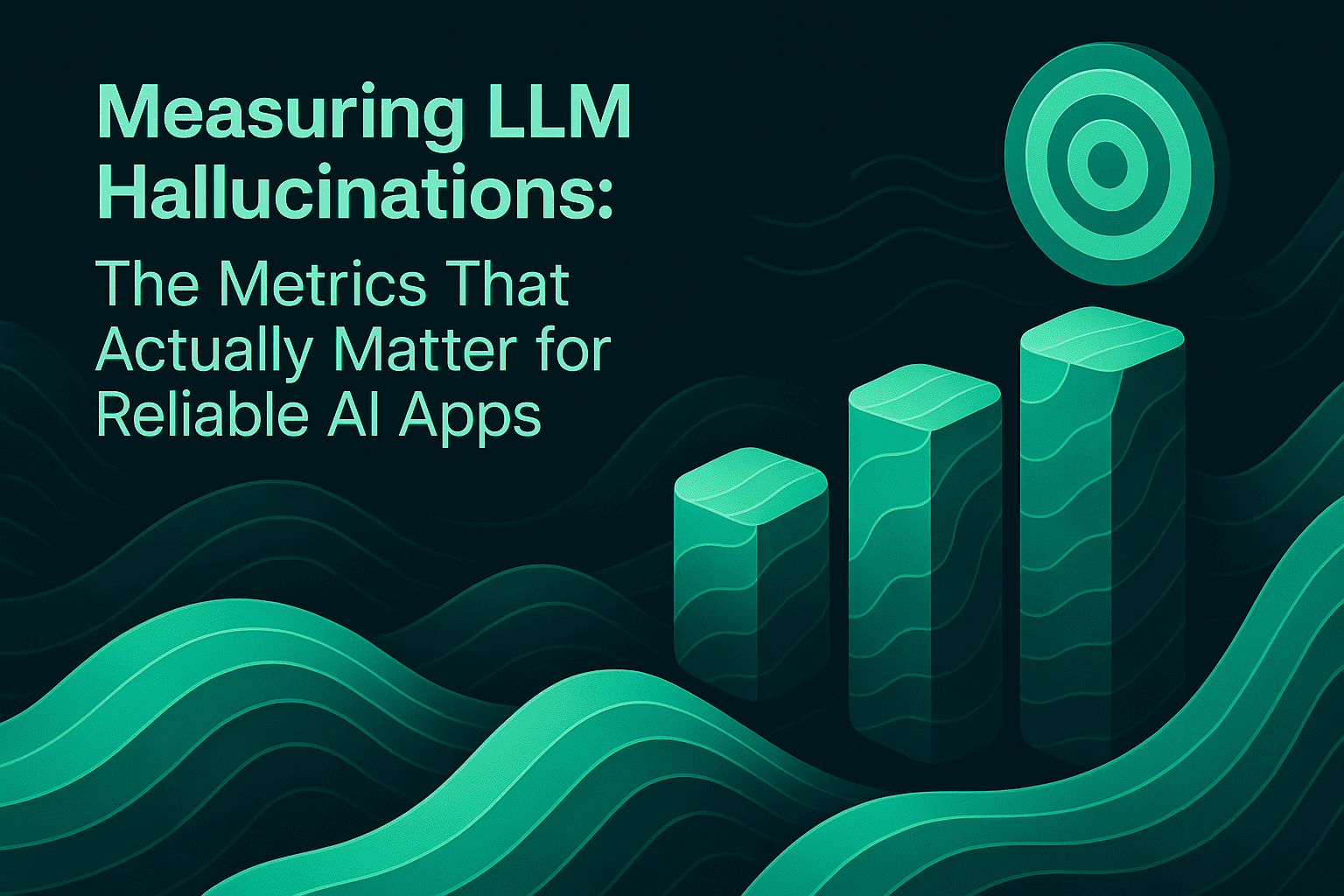Measuring LLM Hallucinations: The Metrics That Actually Matter for Reliable AI Apps
LLM hallucinations aren’t random; they’re measurable. This guide breaks down six core metrics and explains how to wire them into tracing and rubric-driven evaluation so teams can diagnose failures fast and ship reliable AI agents with confidence.

TL;DR
LLM hallucinations cause production failures when teams lack clear metrics to detect where models stray from facts. Six practical metrics matter most: faithfulness, span-level attribution, consistency, context relevance/precision/recall, entailment/contradiction, and operational metrics (latency, tokens, and call counts). Teams that tie these metrics to prompts, retrieval, and decoding can catch failures early, diagnose issues fast, and iterate with confidence. Use rubric-driven LLM-as-a-judge evaluation alongside distributed tracing to close the feedback loop and ship reliable AI apps.
LLM-powered apps fail in production most often because teams cannot see where and why the model strays from facts. The fastest path to reliability is to close the feedback loop with a compact set of evaluation metrics that reveal real failure modes, then use those signals to tune prompts, retrieval, and agent behavior.
This article lays out the practical metrics that matter, how they connect to day-to-day engineering work, and small examples that show them in action. It also points to workflows that operationalize these ideas at scale using rubric-driven judgment in LLM-as-a-judge and end-to-end agent tracing.
Why Hallucination Metrics Matter for Production Reliability
Hallucinations are fluent outputs that are wrong, unsupported, or inconsistent with context. Two things make them dangerous in production: they are hard to spot at runtime, and they often look helpful.
Metrics turn that ambiguity into evidence. When teams measure faithfulness, attribution, and consistency as part of their pipelines, they catch failures before users do and learn which changes actually reduce risk. A compact, repeatable metric set also shortens diagnosis time during incidents because engineers can trace bad outputs to the exact step that slipped.
A Pragmatic Metric Set You Can Adopt Now
Faithfulness: Do claims match provided evidence?
Faithfulness means the answer's factual claims align with the retrieved passages or tool outputs the agent used. A strong faithfulness check compares each sentence to the exact source span it cites and penalizes unsupported claims. For a reference implementation pattern, see rubric-based grading in LLM-as-a-judge, where a judge model applies a concise rubric to score correctness and faithfulness in context.
Example: Your RAG system answers "Acme's refund window is 60 days" while the policy snippet says "30 days." Faithfulness flags the mismatch at the sentence level and attaches the offending span ID. Engineers update retrieval reranking and tighten prompt instructions to "quote the policy verbatim and cite the passage," then re-run evals to confirm the fix.
Attribution (span-level): Are sources present, relevant, and specific?
Attribution checks that answers include citations when required, that cited passages actually support the claim, and that citations point to specific spans (section/line or chunk ID) rather than generic document headers. A good rubric awards full credit only when each claim that exceeds general knowledge is tied to a concrete passage with precise span references. For practical tuning tips, see the prompt engineering guide.
Example: The agent returns a helpful paragraph with "Source: Handbook.pdf." The metric fails because the citation is not span-level. After prompt tuning to "cite exact section and line," accuracy improves and downstream reviewers spend less time tracking provenance.
Consistency: Do similar inputs produce similar behavior?
Consistency means similar queries yield aligned answers across independent samples. It's a simple way to catch fragile prompts or decoding settings. Estimate consistency by sampling multiple generations per query and scoring agreement among final answers. In pipelines that rely on multi-path reasoning, combine self-consistency selection with a post-filter faithfulness check to avoid majority agreement on a wrong claim.
Example: For "How long is the warranty," your agent alternates between 6 and 12 months. Consistency rate drops. You reduce temperature and clarify the instruction to "answer only from the policy context." The rate returns to target, and faithfulness confirms the 12-month answer was never supported.
Context relevance, precision, and recall: Detect retrieval gaps
Context metrics highlight patterns that correlate with hallucination risk:
- Context relevance: Retrieved content is topically aligned with the query.
- Context precision: Retrieved chunks contain the necessary facts with high signal-to-noise.
- Context recall: All required facts are present for the question, including multi-hop coverage.
Two diagnostics help operationalize these:
- Retrieved-but-unused: The top passage was not referenced by the final answer.
- Generated-without-evidence: Claims appear with no supporting source in the context window.
See RAG-specific guidance on retrieval and windowing in the RAG evaluation guide.
Example: The agent retrieves three policy snippets but the answer cites none. Generated-without-evidence spikes for this segment. You add an output contract that requires a "citations" JSON field per claim and a validator that fails the turn when the array is empty. Production regressions decline.
Entailment and contradiction: Does the answer conflict with retrieved passages?
Entailment/contradiction checks explicitly test whether the answer negates or distorts source content. It differs from faithfulness by focusing on logical entailment. In agent workflows, contradiction flags are useful for alerts because a single conflict can trigger escalation rules even when other metrics pass. See patterns in the agent workflow metrics guide.
Example: The source says "Upgrades are not available on discounted tickets," but the agent tells a user "Upgrades are available." Contradiction score fires, and your observability pipeline routes the case to human review while marking the trace for prompt refinement. For tracing best practices, review AI observability.
Operational metrics: Monitor latency, tokens, and tool/LLM call counts
Operational metrics keep quality stable under cost and performance pressure. Many hallucinations creep in when prompts expand, context windows grow, or tool sequencing becomes brittle. Track p95 latency, total tokens, LLM call counts, and tool call counts per turn, then correlate with faithfulness and entailment/contradiction scores. If faithfulness drops with longer contexts, prefer better reranking over larger windows. For alerting patterns, see why evals matter.
Example: A prompt change raises average tokens by 25% and faithfulness falls in long answers. You split the task into retrieve-then-answer steps, reduce context width, and add a short "reason from citations" section. Both operational and quality metrics recover.
How Teams Use These Signals to Improve Agents
Tie metrics to prompts, retrieval, and decoding
Reliable teams don't chase global "accuracy" alone. They use faithfulness and attribution to shape prompt instructions, consistency to set decoding parameters, and context relevance/precision/recall to tune chunking and reranking. After each change, they re-run the same metric suite on golden datasets and shadow traffic. When scores clear thresholds, the change ships. If not, traces tell them exactly where to adjust.
Make judgment repeatable with rubrics
LLM-as-a-judge turns qualitative checks into repeatable evaluations by giving a capable model a tight rubric, clear examples, and a constrained output format. The judge reads the task context, the candidate answer, and any references, then returns scalar scores with short rationales. See the practical framing in LLM-as-a-judge.
Keep evaluation close to observability
Metrics matter most when they sit next to traces. Engineers should be able to click from a low faithfulness score to the exact generation, tool call, and retrieval span that drove the answer. That end-to-end view enables fast root cause analysis and targeted fixes during incidents. Review agent observability best practices.
A Simple Workflow to Close the Loop
1) Define acceptance criteria per task family.
For support Q&A, require faithfulness above a threshold, span-level attribution, and zero entailment/contradiction failures with context.
2) Build compact golden datasets.
Include real queries, retrieved passages, and expected outcomes. Keep sets small but representative. Version them as policies evolve.
3) Wire metric checks into development.
Run evals on each prompt, retrieval, or decoding change. Block merges when critical metrics fail. Track operational metrics alongside quality.
4) Shadow test and monitor online.
Apply the same metrics to shadow traffic. Alert on entailment/contradiction and generated-without-evidence. Review traces for low scores and convert failures into new goldens. Learn more about LLM monitoring strategies.
5) Iterate with targeted fixes.
Use faithfulness signals to refine prompt scaffolding. Use context relevance/precision/recall to improve chunking and reranking. Use consistency to tune sampling. Re-run, then ship.
Conclusion
Reliable AI apps don't depend on guesswork. They depend on a compact metric set that exposes hallucinations as they happen, ties them to specific agent steps, and guides targeted improvements. Faithfulness, attribution, consistency, context relevance/precision/recall, entailment/contradiction, and operational signals are enough to catch the majority of real failures.
Make these metrics part of development and observability, keep rubrics crisp, and wire them to prompts, retrieval, and decoding decisions. With that feedback loop in place, teams iterate quickly while quality stays predictable. Explore top tools for detecting hallucinations to see how leading platforms implement these patterns.
Start evaluating your agents with rubric-driven workflows in the guide on LLM-as-a-judge, and explore how to monitor traces and quality together in the Maxim Docs.
Related Resources
Evaluation Guides:
- How to evaluate AI agents effectively
- Top 5 tools to detect hallucinations in AI applications
- AI hallucinations in 2025: causes, impact, and solutions
Implementation Resources:
- RAG debugging: identifying issues in retrieval-augmented generation
- LLM-as-a-judge: a practical, reliable path to evaluating AI systems at scale
- AI reliability: how to build trustworthy AI systems
Ready to evaluate and observe your LLM agents at scale? Request a demo or sign up.


